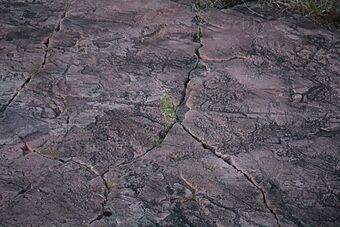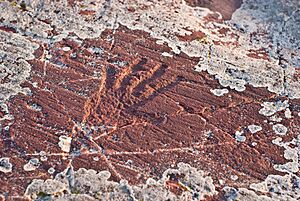Jeffers Petroglyphs facts for kids
Quick facts for kids |
|
|
Jeffers Petroglyphs Site
|
|

Jeffers Petroglyphs in 2024
|
|
| Nearest city | Jeffers, Minnesota |
|---|---|
| NRHP reference No. | 70000291 |
| Added to NRHP | October 15, 1970 |
The Jeffers Petroglyphs site is a special place in southwestern Minnesota. It's an outcrop of rock covered with ancient carvings. These carvings, called petroglyphs, were made by Native American people long ago.
The carvings are found on a rock ridge called Red Rock Ridge. This ridge is about 23 miles (37 km) long. The part with the carvings is about 150 feet (46 m) wide and 650 feet (198 m) long. It's surrounded by beautiful, untouched prairie land.
Some carvings look like designs used by the Dakota Indians. These designs are similar to those found on their hide paintings and quill designs. Other carvings look much older and are different from these styles. You can also see old wagon trail ruts crossing the site. One of these might have been a stagecoach route from New Ulm, Minnesota to Sioux Falls, South Dakota.
Contents
Uncovering Ancient Art: How Old Are the Carvings?
It's hard to know the exact age of all the petroglyphs. Scientists believe the oldest ones were made between 9,000 and 7,000 years ago. That's a very long time before recorded history!
Some symbols at Jeffers are like those found in Kentucky. These symbols, showing atlatls (ancient spear throwers), are about 5,000 years old. Other carvings show spear points used by hunters during that same time.
Later carvings include images of thunderbirds, dragonflies, and turtles. There are also carvings of shamans, who were spiritual leaders. These symbols were important to tribes like the Otoe tribe, Sioux, and Iowa tribe. These carvings are thought to be from about 900 CE to 1750 CE.
In total, there are over 4,000 images carved into the rock. The rock itself was smoothed flat by glaciers about 14,000 years ago.
What Do the Jeffers Petroglyphs Mean?
People have different ideas about why these carvings were made. Some experts think they were used for "hunting magic" to help hunters find animals. Others believe they were part of sacred ceremonies. They might also have recorded important events in the lives of warriors or chiefs.
However, these are just guesses. No one knows for sure the exact age or purpose of all the carvings. Many Native Americans see the Jeffers site as a very special and spiritual place. They believe it's more than just a place for study. A Dakota elder named Jerry Flute once said that it's a place where "Grandmother Earth speaks of the past, present and future."
Visiting the Jeffers Petroglyphs Site
The Minnesota Historical Society bought the site in 1966. It was added to the National Register of Historic Places in 1970. This means it's recognized as an important historical landmark.
The site is open to the public from May through September. It's a great place to learn about history and nature. The area around the petroglyphs is also special. It has two important areas of tallgrass prairie. These prairies are home to rare plants and animals. You might see prairie bush clover, upland sandpiper birds, or regal fritillary butterflies.
Learning at the Visitor Center
The visitor center is open during the same months as the site. It has fun, hands-on exhibits and a video presentation. You can learn about archaeology and how Native Americans lived. They offer programs on topics like how to use an atlatl or how to make cordage. You can also learn about the amazing wildlife and plants of the prairie.
Stargazing at Jeffers Petroglyphs
The Jeffers Petroglyphs site is also known for its incredibly dark night skies. Each year, an event called "Starry Night, Prairie Night" is held here. Amateur astronomers come with their telescopes to share views of the stars. It's a fantastic opportunity to see the night sky much clearer than in most cities. The site is rated as "green" by the Clear Sky Chart, meaning it has very little light pollution.





